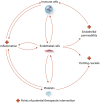The effects of sepsis on endothelium and clinical implications
- PMID: 32215570
- PMCID: PMC7810126
- DOI: 10.1093/cvr/cvaa070
The effects of sepsis on endothelium and clinical implications
Abstract
Sepsis accounts for nearly 700 000 deaths in Europe annually and is caused by an overwhelming host response to infection resulting in organ failure. The endothelium is an active contributor to sepsis and as such represents a major target for therapy. During sepsis, endothelial cells amplify the immune response and activate the coagulation system. They are both a target and source of inflammation and serve as a link between local and systemic immune responses. In response to cytokines produced by immune cells, the endothelium expresses adhesion molecules and produces vasoactive compounds, inflammatory cytokines, and chemoattractants, thus switching from an anticoagulant to procoagulant state. These responses contribute to local control of infection, but systemic activation can lead to microvascular thrombosis, capillary permeability, hypotension, tissue hypoxia, and ultimately tissue damage. This review focuses on the role of the endothelium in leucocyte adhesion and transmigration as well as production of reactive oxygen and nitrogen species, microRNAs and cytokines, formation of signalling microparticles, and disseminated intravascular coagulation. We also discuss alterations in endothelial permeability and apoptosis. Finally, we review the diagnostic potential of endothelial markers and endothelial pathways as therapeutic targets for this devastating disease.
Keywords: Diagnosis; Endothelium; Mechanism; Sepsis; Treatment.
Published on behalf of the European Society of Cardiology. All rights reserved. © The Author(s) 2020. For permissions, please email: journals.permissions@oup.com.
Figures





Similar articles
-
Inflammation and thrombosis: roles of neutrophils, platelets and endothelial cells and their interactions in thrombus formation during sepsis.J Thromb Haemost. 2018 Feb;16(2):231-241. doi: 10.1111/jth.13911. Epub 2017 Dec 21. J Thromb Haemost. 2018. PMID: 29193703 Review.
-
Endothelial Responses in Sepsis.Am J Respir Crit Care Med. 2020 Aug 1;202(3):361-370. doi: 10.1164/rccm.201910-1911TR. Am J Respir Crit Care Med. 2020. PMID: 32101446 Review.
-
Nonclassical monocytes in cardiovascular physiology and disease.Am J Physiol Cell Physiol. 2021 May 1;320(5):C761-C770. doi: 10.1152/ajpcell.00326.2020. Epub 2021 Feb 17. Am J Physiol Cell Physiol. 2021. PMID: 33596150 Review.
-
Thrombomodulin as a Physiological Modulator of Intravascular Injury.Front Immunol. 2020 Sep 16;11:575890. doi: 10.3389/fimmu.2020.575890. eCollection 2020. Front Immunol. 2020. PMID: 33042158 Free PMC article. Review.
-
Microparticles are vectors of paradoxical information in vascular cells including the endothelium: role in health and diseases.Pharmacol Rep. 2008 Jan-Feb;60(1):75-84. Pharmacol Rep. 2008. PMID: 18276988 Review.
Cited by
-
Organ crosstalk and dysfunction in sepsis.Ann Intensive Care. 2024 Sep 19;14(1):147. doi: 10.1186/s13613-024-01377-0. Ann Intensive Care. 2024. PMID: 39298039 Free PMC article. Review.
-
Sars-Cov2 Induced Biochemical Mechanisms in Liver Damage and Intestinal Lesions.Indian J Clin Biochem. 2022 Nov 12;38(4):1-10. doi: 10.1007/s12291-022-01089-x. Online ahead of print. Indian J Clin Biochem. 2022. PMID: 36407686 Free PMC article.
-
Predictive role of selected biomarkers in differentiating gram-positive from gram-negative sepsis in surgical patients: a retrospective study.Anaesthesiol Intensive Ther. 2023;55(5):319-325. doi: 10.5114/ait.2023.134214. Anaesthesiol Intensive Ther. 2023. PMID: 38282497 Free PMC article.
-
The Intricate Role of Non-Coding RNAs in Sepsis-Associated Disseminated Intravascular Coagulation.Int J Mol Sci. 2023 Jan 30;24(3):2582. doi: 10.3390/ijms24032582. Int J Mol Sci. 2023. PMID: 36768905 Free PMC article. Review.
-
Targeting Cytokines, Pathogen-Associated Molecular Patterns, and Damage-Associated Molecular Patterns in Sepsis via Blood Purification.Int J Mol Sci. 2021 Aug 18;22(16):8882. doi: 10.3390/ijms22168882. Int J Mol Sci. 2021. PMID: 34445610 Free PMC article. Review.
References
-
- Singer M, Deutschman CS, Seymour CW, Shankar-Hari M, Annane D, Bauer M, Bellomo R, Bernard GR, Chiche JD, Coopersmith CM, Hotchkiss RS, Levy MM, Marshall JC, Martin GS, Opal SM, Rubenfeld GD, van der Poll T, Vincent JL, Angus DC.. The Third International Consensus definitions for sepsis and septic shock (sepsis-3). JAMA 2016;315:801–810. - PMC - PubMed
-
- The Brussels Sepsis Resolution Global Sepsis Alliance, Brussels, March 20th, 2018. (Meeting).
-
- Nunnally ME, Patel A.. Sepsis—what’s new in 2019? Curr Opin Anaesthesiol 2019;32:163–168. - PubMed
-
- Hack CE, Zeerleder S.. The endothelium in sepsis: source of and a target for inflammation. Crit Care Med 2001;29:S21–S27. - PubMed
-
- Reinhart K, Bayer O, Brunkhorst F, Meisner M.. Markers of endothelial damage in organ dysfunction and sepsis. Crit Care Med 2002;30:S302–S312. - PubMed
Publication types
MeSH terms
Substances
Grants and funding
LinkOut - more resources
Full Text Sources
Medical

